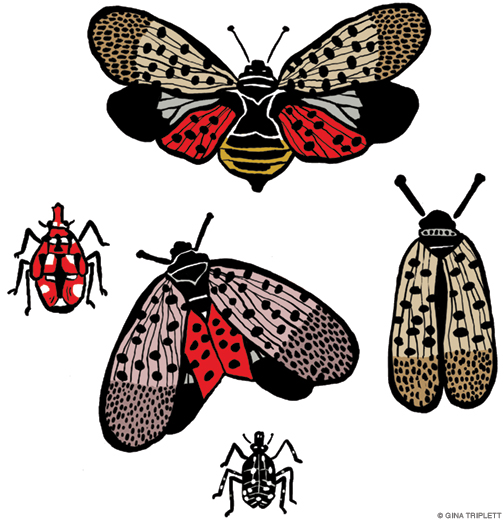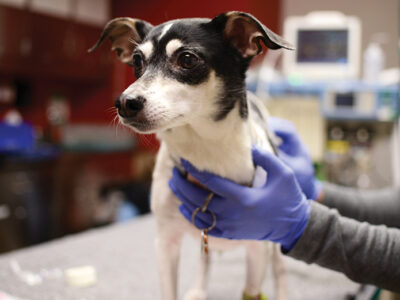
If you’ve spent any time in Pennsylvania, New Jersey, or other eastern states this summer and fall, you may have found yourself stomping on spotted lanternflies—an invasive planthopper that wreaks havoc on agriculture by feeding on the sap of many economically important plants, from grapevines to apple trees. And perhaps you’ve wondered whether your efforts are fruitless, as you likely saw many more swarm trees, sidewalks, and buildings the next time out of your house.
Penn’s School of Veterinary Medicine is joining the fight—by unleashing dogs.
A new Penn Vet pilot training program, announced in September, utilizes scent detection dogs to identify spotted lanternfly egg masses, which researchers hope will neutralize the destructive insects before they mature.
Backed by funding from the Pennsylvania Department of Agriculture (PDA) and led by Cynthia Otto, professor of working dog sciences and sports medicine and director of Penn Vet’s Working Dog Center [“Working Like Dogs,” Jan|Feb 2013], the pioneering study began in December 2019. Dead lanternfly eggs, which were collected from tree bark, were initially presented to dogs in a laboratory setting to see if they could recognize the egg mass odor and ignore the odor of tree bark. The dogs were then asked to identify live eggs in realistic environments, such as on cars or hidden under things. Results showed that they correctly identified egg masses with up to 95 percent accuracy while also correctly ignoring non-target scents up to 93 percent of the time.
“With up to 300 million smell receptors in their noses, properly trained dogs are uniquely positioned to provide an effective surveillance and management strategy in identifying and removing these egg masses that may otherwise go undetected,” Otto said in a news release, which also stated that the program’s launch came at a “critical time for spotted lanternfly management in Pennsylvania.”
Native to Asia, the species was first identified in the state in 2014. There were 62,924 public reports of spotted lanternflies in Pennsylvania this year as of August 31 (and surely countless more that were seen or squashed without being reported)—up more than 70 percent from the same time period last year. Beyond causing severe damage to trees, the insects pose a particular threat to the grape, apple, hops, and hardwood industries and could cost the state’s economy $324 million annually and more than 2,800 jobs, per a Penn State economic report cited on the PDA website.
The next step for Penn Vet researchers will be to deploy a group of Working Dog Center trainees to sniff out egg masses, including a German shepherd named Lucky, “whose future job as the Pennsylvania Department of Agriculture’s first spotted lanternfly scent detection dog,” the release noted, “will be instrumental in safeguarding the state against evolving threats posed by the species.” —DZ




